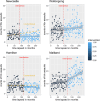An overlooked effect: domestic violence and alcohol policies in the night-time economy
- PMID: 36967701
- PMCID: PMC10952798
- DOI: 10.1111/add.16192
An overlooked effect: domestic violence and alcohol policies in the night-time economy
Abstract
Background and aims: Restrictive late-night alcohol policies are aimed at reducing alcohol-related violence but, to date, no evaluations of their impact on family and domestic violence have been conducted. This study aimed to measure whether modifying the drinking environment and restricting on-site trading hours affected reported rates of family and domestic violence.
Design, setting and participants: This study used a non-equivalent control group design with two treatment sites and two matched control sites with pre- and postintervention data on rates of family and domestic violence assaults within local catchment areas of four late-night entertainment precincts in New South Wales, Australia, covering a population of 27 309 people. Participants comprised monthly counts of police-recorded incidents of domestic violence assaults from January 2001 to December 2019.
Interventions and comparators: Two variations of restrictive late-night interventions were used: restricted entry to late-night venues after 1:30 a.m., trading ceasing at 3:30 a.m. and other restrictions on alcohol service (Newcastle); and restricted entry to late-night venues after 1 a.m. and a range of restrictions on alcohol service (Hamilton). The comparators were no restrictions on late-night trading or modifications of the drinking environment (Wollongong and Maitland).
Measurements: Measurements involved the rate, type and timing of reported family and domestic violence assaults.
Findings: Reported rates of domestic violence assaults fell at both intervention sites, while reported domestic violence assaults increased over time in the control sites. The protective effects in Newcastle were robust and statistically significant across three main models. The relative reduction associated with the intervention in Newcastle was 29% (incidence rate ratio = 0.71, 95% confidence interval: 0.60-0.83) and an estimated 204 assaults were prevented across the duration of the study. The protective effects found in Hamilton were not consistently supported across the three main models.
Conclusions: Increases to late-night alcohol restrictions may reduce rates of domestic violence.
Keywords: Alcohol-related violence; Australia; evaluation; family violence; lockout laws; violence in the night-time economy.
© 2023 The Authors. Addiction published by John Wiley & Sons Ltd on behalf of Society for the Study of Addiction.
Conflict of interest statement
None to declare.
Figures
Similar articles
-
Longer-term impacts of trading restrictions on alcohol-related violence: insights from New South Wales, Australia.Addiction. 2022 May;117(5):1304-1311. doi: 10.1111/add.15774. Epub 2021 Dec 30. Addiction. 2022. PMID: 34859528
-
Reduction in Late-Night Violence following the Introduction of National New Zealand Trading Hour Restrictions.Alcohol Clin Exp Res. 2020 Mar;44(3):722-728. doi: 10.1111/acer.14285. Epub 2020 Feb 17. Alcohol Clin Exp Res. 2020. PMID: 31957024
-
The combined impact of higher-risk on-license venue outlet density and trading hours on serious assaults in night-time entertainment precincts.Drug Alcohol Depend. 2021 Jun 1;223:108720. doi: 10.1016/j.drugalcdep.2021.108720. Epub 2021 Apr 12. Drug Alcohol Depend. 2021. PMID: 33866071
-
A mapping review of evaluations of alcohol policy restrictions targeting alcohol-related harm in night-time entertainment precincts.Int J Drug Policy. 2018 Dec;62:1-13. doi: 10.1016/j.drugpo.2018.09.012. Epub 2018 Oct 19. Int J Drug Policy. 2018. PMID: 30347331 Review.
-
Summarising the impacts of the Queensland Alcohol-related violence and Night-Time Economy (QUANTEM) project.Drug Alcohol Rev. 2021 Jul;40(5):755-760. doi: 10.1111/dar.13272. Epub 2021 May 19. Drug Alcohol Rev. 2021. PMID: 34008893 Review.
Cited by
-
Examination of patients presenting to the emergency department as "apparently drunk".Ir J Med Sci. 2025 Feb;194(1):375-384. doi: 10.1007/s11845-025-03868-w. Epub 2025 Jan 16. Ir J Med Sci. 2025. PMID: 39821069 Free PMC article.
-
Can alcohol policy prevent harms to women and children from men's alcohol consumption? An overview of existing literature and suggested ways forward.Int J Drug Policy. 2023 Sep;119:104148. doi: 10.1016/j.drugpo.2023.104148. Epub 2023 Aug 2. Int J Drug Policy. 2023. PMID: 37540918 Free PMC article. Review.
References
-
- Cafferky BM, Mendez M, Anderson JR, Stith SM. Substance use and intimate partner violence: a meta‐analytic review. Psychol Violence. 2018;8:110–131.
-
- Green J, Plant MA. Bad bars: a review of risk factors. J Subst Abuse. 2007;12:157–189.
-
- Miller P, Wells S, Hobbs R, Zinkiewicz L, Curtis A, Graham K. Alcohol, masculinity, honour and male barroom aggression in an Australian sample. Drug Alcohol Rev. 2014;33:136–143. - PubMed
-
- Menéndez P, Tusell F, Weatherburn D. The effects of liquor licensing restriction on alcohol‐related violence in NSW, 2008–13. Addiction. 2015;110:1574–1582. - PubMed
Publication types
MeSH terms
LinkOut - more resources
Full Text Sources
Medical


